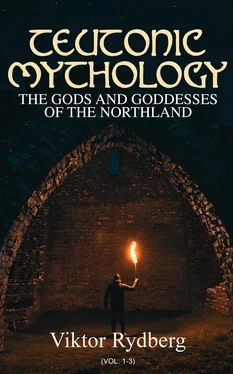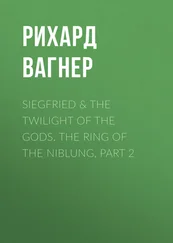Viktor Rydberg - Teutonic Mythology - The Gods and Goddesses of the Northland (Vol. 1-3)
Здесь есть возможность читать онлайн «Viktor Rydberg - Teutonic Mythology - The Gods and Goddesses of the Northland (Vol. 1-3)» — ознакомительный отрывок электронной книги совершенно бесплатно, а после прочтения отрывка купить полную версию. В некоторых случаях можно слушать аудио, скачать через торрент в формате fb2 и присутствует краткое содержание. Жанр: unrecognised, на английском языке. Описание произведения, (предисловие) а так же отзывы посетителей доступны на портале библиотеки ЛибКат.
- Название:Teutonic Mythology: The Gods and Goddesses of the Northland (Vol. 1-3)
- Автор:
- Жанр:
- Год:неизвестен
- ISBN:нет данных
- Рейтинг книги:4 / 5. Голосов: 1
-
Избранное:Добавить в избранное
- Отзывы:
-
Ваша оценка:
- 80
- 1
- 2
- 3
- 4
- 5
Teutonic Mythology: The Gods and Goddesses of the Northland (Vol. 1-3): краткое содержание, описание и аннотация
Предлагаем к чтению аннотацию, описание, краткое содержание или предисловие (зависит от того, что написал сам автор книги «Teutonic Mythology: The Gods and Goddesses of the Northland (Vol. 1-3)»). Если вы не нашли необходимую информацию о книге — напишите в комментариях, мы постараемся отыскать её.
One of Rydberg's mythological theories developed in this book is that of a vast World Mill which rotates the heavens, which he believed was an integral part of Old Norse mythic cosmology.
Teutonic Mythology: The Gods and Goddesses of the Northland (Vol. 1-3) — читать онлайн ознакомительный отрывок
Ниже представлен текст книги, разбитый по страницам. Система сохранения места последней прочитанной страницы, позволяет с удобством читать онлайн бесплатно книгу «Teutonic Mythology: The Gods and Goddesses of the Northland (Vol. 1-3)», без необходимости каждый раз заново искать на чём Вы остановились. Поставьте закладку, и сможете в любой момент перейти на страницу, на которой закончили чтение.
Интервал:
Закладка:
The result of the investigation is that Gullveig-Heidr , Aurboda , and Angrboda are different names for the different hypostases of the thrice-born and thrice-burnt one, and that Hyrrokin , "the fire-smoked," is an epithet common to all these hypostases.
36.
THE WORLD WAR ( continued ). THE BREACH OF PEACE BETWEEN ASAS AND VANS. FRIGG, SKADE, AND ULL IN THE CONFLICT. THE SIEGE OF ASGARD. THE VAFERFLAMES. THE DEFENCE AND SURROUNDINGS OF ASGARD. THE VICTORY OF THE VANS.
Table of Contents
When the Asas had refused to give satisfaction for the murder of Gulveig, and when Odin, by hurling his spear, had indicated that the treaty of peace between him and the Vans was broken, the latter leave the assembly hall and Asgard. This is evident from the fact that they afterwards return to Asgard and attack the citadel of the Asa clan. The gods are now divided into two hostile camps: on the one side Odin and his allies, among whom are Heimdal (see Nos. 38, 39, 40), and Skade; on the other Njord, Frigg (Saxo, Hist. , 42–44), Frey, Ull (Saxo, Hist ., 130, 131), and Freyja and her husband Svipdag, besides all that clan of divinities who were not adopted in Asgard, but belong to the race of Vans and dwell in Vanaheim.
So far as Skade is concerned the breach between the gods seems to have furnished her an opportunity of getting a divorce from Njord, with whom she did not live on good terms. According to statements found in the myths, Thjasse's daughter and he were altogether too different in disposition to dwell in peace together. Saxo ( Hist. , 53 ff.) and the Younger Edda (p. 94) have both preserved the record of a song which describes their different tastes as to home and surroundings. Skade loved Thrymheim, the rocky home of her father Thjasse, on whose snow-clad plains she was fond of running on skees and of felling wild beasts with her arrows; but when Njord had remained nine days and nine nights among the mountains he was weary of the rocks and of the howling of wolves, and longed for the song of swans on the sea-strand. But when Skade accompanied him thither she could not long endure to be awakened every morning by the shrieking of sea-fowls. In Grimnismal, 11, it is said that Skade "now" occupies her father's "ancient home" in Thrymheim, but Njord is not named there. In a strophe by Thord Sjarekson (Younger Edda, 262) we read that Skade never became devoted to the Vana-god ( nama snotr una godbrúdr Vani ), and Eyvind Skalda-spiller relates in Haleygjatal that there was a time when Odin dwelt í Manheimum together with Skade, and begat with her many sons. With Manheimar is meant that part of the world which is inhabited by man; that is to say, Midgard and the lower world, where are also found a race of menskir menn (see Nos. 52, 53, 59, 63), and the topographical counterpart of the word is Ásgardr . Thus it must have been after his banishment from Asgard, while he was separated from Frigg and found refuge somewhere in Manheimar , that Odin had Skade for his wife. Her epithet in Grimnismal, skír brúdr goda , also seems to indicate that she had conjugal relations with more than one of the gods.
While Odin was absent and deposed as ruler of the world, Ull has occupied so important a position among the ruling Vans that, according to the tradition preserved in Saxo, they bestowed upon him the task and honour which until that time had belonged to Odin ( Dii … Ollerum quendam non solum in regni, sed etiam in divinitatis infulas subrogavere — Hist. , 130). This is explained by the fact that Njord and Frey, though valtívar and brave warriors when they are invoked, are in their very nature gods of peace and promoters of wealth and agriculture, while Ull is by nature a warrior. He is a skilful archer, excellent in a duel, and hefir hermanns atgervi (Younger Edda, i. 102). Also after the reconciliation between the Asas and Vans, Thor's stepson Ull has held a high position in Asgard, as is apparently corroborated by Odin's words in Grimnismal, 41 ( Ullar hylli ok allra góda ).
From the mythic accounts in regard to the situation and environment of Asgard we may conclude that the siege by the Vans was no easy task. The home of the Asas is surrounded by the atmospheric ocean, whose strong currents make it difficult for the mythic horses to swim to it (see Nos. 65, 93). The bridge Bifrost is not therefore superfluous, but it is that connection between the lower worlds and Asgard which the gods daily use, and which must be captured by the enemy before the great cordon which encloses the shining halls of the gods can be attacked. The wall is built of "the limbs of Lerbrimer" (Fjolsv., 1), and constructed by its architect in such a manner that it is a safe protection against mountain-giants and frost-giants (Younger Edda, 134). In the wall is a gate wondrously made by the artist-brothers who are sons of "Solblinde" ( Valgrind —Grimnism., 22; thrymgjöll —Fjölsvimsm., 10). Few there are who understand the lock of that gate, and if anybody brings it out of its proper place in the wall-opening where it blocks the way for those who have no right to enter, then the gate itself becomes a chain for him who has attempted such a thing ( Forn er su grind, enn that fáir vito, hor hve er i lás um lokin —Grimn., 22. Fjöturr fastr verdr vid faranda hvern er hana hefr frá hlidi —Fjölsv., 10).
Outside of the very high Asgard cordon and around it there flows a rapid river (see below), the moat of the citadel. Over the eddies of the stream floats a dark, shining ignitible mist. If it is kindled it explodes in flames, whose bickering tongues strike their victims with unerring certainty. It is the vaferloge , "the bickering flame," "the quick fire," celebrated in ancient songs— vafrlogi , vafreydi , skjót-brinni . It was this fire which the gods kindled around Asgard when they saw Thjasse approaching in eagle guise. In it their irreconcilable foe burnt his pinions, and fell to the ground. "Haustlaung," Thjodolf's poem, says that when Thjasse approached the citadel of the gods "the gods raised the quick fire and sharpened their javelins"— Hófu skjót; en skófu sköpt; ginnregin brinna . The "quick fire," skjót-brinni , is the vaferloge . [21]
The material of which the ignitible mist consists is called "black terror-gleam." It is or odauccom ; that is to say, ofdauccom ognar ljoma (Fafn., 40) ( cp. myrckvan vafrloga —Skirn., 8, 9; Fjolsv., 31). It is said to be "wise," which implies that it consciously aims at him for whose destruction it is kindled.
How a water could be conceived that evaporates a dark, ignitible mist we find explained in Thorsdrapa. The thunder-storm is the "storm of the vaferfire," and Thor is the "ruler of the chariot of the vaferfire-storm" ( vafreyda hreggs húfstjóri ). Thus the thunder-cloud contains the water that evaporates a dark material for lightning. The dark metallic colour which is peculiar to the thunder-cloud was regarded as coming from that very . material which is the "black terror-gleam" of which lightning is formed. When Thor splits the cloud he separates the two component parts, the water and the vafermist; the former falls down as rain, the latter is ignited and rushes away in quick, bickering, zigzag flames—the vaferfires. That these are "wise" was a common Aryan belief. They do not proceed blindly, but know their mark and never miss it.
The river that foams around Asgard thus has its source in the thunder-clouds; not as we find them after they have been split by Thor, but such as they are originally, swollen with a celestial water that evaporates vafermist. All waters—subterranean, terrestrial, and celestial—have their source in that great subterranean fountain Hvergelmer. Thence they come and thither they return (Grimn., 26; see Nos. 59, 63, 33). Hvergelmer's waters are sucked up by the northern root of the world-tree; they rise through its trunk, spread into its branches and leaves, and evaporate from its crown into a water-tank situated on the top of Asgard, Eikthyrnir , in Grimnismal, str. 26, symbolised as a "stag" [22]who stands on the roof of Odin's hall and out of whose horns the waters stream down into Hvergelmer. Eikthyrnir is the great celestial water-tank which gathers and lets out the thunder-cloud. In this tank the Asgard river has its source, and hence it consists not only of foaming water but also of ignitible
Читать дальшеИнтервал:
Закладка:
Похожие книги на «Teutonic Mythology: The Gods and Goddesses of the Northland (Vol. 1-3)»
Представляем Вашему вниманию похожие книги на «Teutonic Mythology: The Gods and Goddesses of the Northland (Vol. 1-3)» списком для выбора. Мы отобрали схожую по названию и смыслу литературу в надежде предоставить читателям больше вариантов отыскать новые, интересные, ещё непрочитанные произведения.
Обсуждение, отзывы о книге «Teutonic Mythology: The Gods and Goddesses of the Northland (Vol. 1-3)» и просто собственные мнения читателей. Оставьте ваши комментарии, напишите, что Вы думаете о произведении, его смысле или главных героях. Укажите что конкретно понравилось, а что нет, и почему Вы так считаете.











